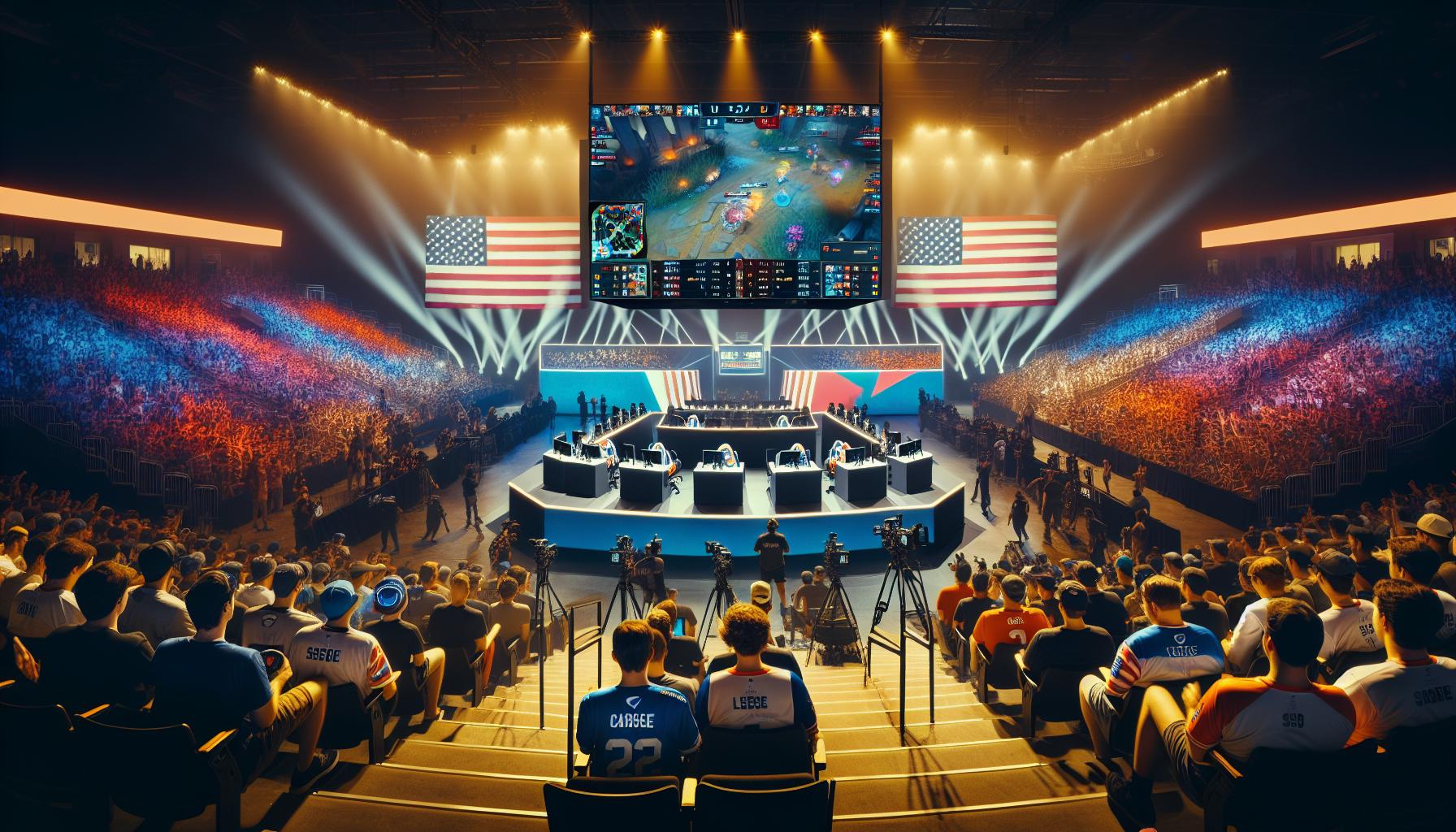Key Takeaways
- Transformative Journey: Esports has evolved from informal competitions in arcades to a multi-billion dollar global industry, showcasing its exponential growth and widespread appeal.
- Milestones in History: Key events, like the Space Invaders Championship and World Cyber Games, played a crucial role in legitimizing competitive gaming and expanding its audience.
- Impact of Online Gaming: The rise of online gaming platforms facilitated global competition among gamers, significantly shaping the esports landscape and making it more accessible.
- Professionalization of Teams: The emergence of professional esports teams in the 2000s marked a shift towards organized competition, providing players with career opportunities and increasing industry legitimacy.
- Mainstream Recognition: Esports gained traction through extensive media coverage and sponsorships from major brands, contributing to its acceptance as a legitimate entertainment sector.
- Future Prospects: Technological advancements and predictions of market growth indicate that esports will continue to evolve, potentially reaching new audiences and integrating more with traditional sports.
Esports has transformed from a niche hobby into a global phenomenon. What began in the early days of arcade gaming has evolved into a multi-billion dollar industry, captivating millions of fans worldwide. The journey of esports is marked by technological advancements, competitive spirit, and the rise of dedicated communities that have fueled its growth.
As gaming technology improved and internet connectivity expanded, players found new ways to compete and connect. From local tournaments to massive international events, esports has created a vibrant culture that celebrates skill and teamwork. Today, it stands as a testament to how digital competition can bring people together, redefine entertainment, and shape the future of sports.
The History And Evolution of Esports
Esports began as a small community of gamers competing informally. Over time, these competitions evolved into organized events, laying the foundation for the industry.
The Formation of Competitive Gaming
Competitive gaming took root in the 1970s and 1980s with the rise of arcade machines. Games like Space Invaders (1978) fostered local competitions, attracting passionate players. In 1980, the first known esports competition, the Space Invaders Championship, hosted over 10,000 participants across the U.S. This set a precedent for future events, highlighting the potential for gaming as a competitive spectacle.
Landmark Tournaments
The 1990s marked critical developments with landmark tournaments. In 1997, the Red Annihilation tournament for Quake paved the way for larger-scale competitions, offering cash prizes and attracting professional players. This laid the groundwork for future tournaments. In 2000, the World Cyber Games (WCG) emerged, initiating international competitions and further legitimizing esports. The WCG gathered thousands of players and provided a global platform, showcasing the growing popularity and potential of esports.
The Rise of Online Gaming

The rise of online gaming significantly shaped the esports landscape, providing a platform for gamers to connect and compete globally. With advancements in technology and internet accessibility, competitive gaming flourished, attracting a wider audience.
The Impact of the Internet
The internet transformed gaming by enabling real-time interactions among players. High-speed connections established in the late 1990s allowed for smoother gameplay and more extensive online communities. Platforms such as LAN parties and online gaming services, like Battle.net, connected gamers in unprecedented ways. This connectivity laid the groundwork for organized tournaments, allowing individuals from different regions to compete without geographical limitations.
Key Milestones in Online Competitions
Several milestones marked the evolution of online competitions in esports:
- 1997: The organization of the first major online tournament, the “Red Annihilation” tournament for Quake, set a precedent for future competitions by attracting hundreds of participants.
- 1999: The launch of the Cyberathlete Professional League (CPL) established a professional framework for competitive gaming, offering significant cash prizes and sponsorships.
- 2000: The inception of the World Cyber Games (WCG) brought international recognition to esports by featuring players from various countries, further validating competitive gaming’s global appeal.
- 2003: The emergence of services like Xbox Live allowed console players to engage in online multiplayer games, broadening the reach of esports.
- 2006: The Intel Extreme Masters (IEM) created a premiere gaming league that showcased top talent and provided a platform for professional teams.
These milestones reflect a continuous growth trajectory for online gaming, cementing its status as a vital component of the esports ecosystem.
The Growth of Esports in the 2000s

Esports experienced exponential growth in the 2000s, marked by iconic games and the rise of professional teams that changed the competitive gaming landscape.
Major Titles That Shaped the Landscape
Several major titles influenced esports during the 2000s. Counter-Strike 1.6 gained immense popularity, establishing itself as a cornerstone of competitive gameplay due to its tactical depth and team-based mechanics. StarCraft: Brood War solidified its status in South Korea with notable tournaments, fostering a massive following. Warcraft III contributed to the strategy genre and birthed the popular Defense of the Ancients (DotA) mod, eventually paving the way for the MOBA (Multiplayer Online Battle Arena) genre. Other significant titles, including Quake III Arena and Halo 2, expanded the competitive field, attracting diverse player bases and forming tight-knit community networks.
The Emergence of Professional Teams
The 2000s saw the formation of professional esports teams, marking a shift towards structured competition. Teams such as Fnatic, SK Telecom T1, and Team Liquid emerged, creating a competitive framework that attracted talented players and sponsorships. These organizations focused on player development, branding, and fan engagement, promoting a more professional atmosphere. Team participation in tournaments, alongside the establishment of leagues, signified a transition from casual play to serious, organized competitions. The rise of professional teams not only professionalized the industry but also solidified the careers of players, leading to growing recognition and legitimacy in the sports world.
The Mainstream Acceptance of Esports

Esports gained mainstream acceptance through significant media coverage and sponsorship, leading to increased visibility and legitimacy. Global events drew millions of viewers, solidifying esports as a pillar in the entertainment industry.
Media Coverage and Sponsorship
Media coverage transformed perceptions of esports, shifting attention from niche interest to global phenomenon. Traditional sports networks, such as ESPN, began broadcasting esports events, reaching wider audiences. Major publications like The Wall Street Journal and Forbes recognized esports as a legitimate sector, providing extensive coverage and analysis.
Sponsorship played a crucial role in this ascent. Brands such as Red Bull and Coca-Cola invested heavily in esports, associating themselves with popular tournaments and teams. Sponsorships not only provided financial support but also legitimized esports in the eyes of mainstream culture. In 2021, esports sponsorship revenue reached approximately $1.1 billion, illustrating its financial impact and attractiveness to traditional advertisers.
Global Events and Viewership Growth
Global events became pivotal in driving esports’ popularity. Major tournaments, such as The International for Dota 2 and the League of Legends World Championship, attracted millions of viewers both online and in-person. In 2020, The International had a record viewership of over 2.7 million concurrent viewers on platforms like Twitch.
Viewership growth in esports mirrored trends in traditional sports. Events offered immersive experiences, boosting audience engagement through live streaming and social media interaction. In 2021, the global esports audience reached 474 million, with projections forecasting further growth. Such statistics indicate the significance of esports in the entertainment landscape, showcasing its ability to captivate diverse demographics and interests.
The Future of Esports
Esports continues to evolve rapidly, with significant implications for its structure and cultural reach. Various factors, including technology, audience engagement, and market dynamics, will shape its future.
Technological Advancements
Technological advancements play a critical role in the future of esports. Enhanced hardware facilitates higher graphic fidelity and faster processing speeds, creating an immersive gaming experience. Innovations in virtual and augmented reality contribute to new gameplay formats, engaging players and viewers in unique ways. Streaming platforms like Twitch and YouTube provide essential infrastructure, supporting live broadcasts and community interaction. With 5G technology on the horizon, latency will decrease, improving real-time interactions during competitive play. Gamers will access seamless connectivity whether at home or in esports arenas, further integrating esports into social and entertainment ecosystems.
Predictions for the Next Decade
Predictions for the next decade suggest continued growth and diversification of esports. Analysts project that the global esports market could surpass $1.8 billion by 2024, driven by increasing sponsorship deals and media rights revenues. The rise of mobile esports may capture a larger segment of the gaming audience, appealing to casual and competitive gamers alike. Expansion into new regions, particularly in Asia and Africa, may further broaden the spectator base. Additionally, collaborations between traditional sports organizations and esports teams are likely to produce hybrid events, attracting fans from both sectors. As a result, esports will become an even more integrated part of mainstream entertainment, providing pathways for aspiring players and content creators.
Esports has undeniably transformed from a casual pastime into a dynamic global industry. Its evolution reflects not only advancements in technology but also a growing cultural acceptance that has made competitive gaming a staple in entertainment. The rise of professional teams and landmark tournaments has established a vibrant community that thrives on skill and teamwork.
As the esports landscape continues to evolve, it holds immense potential for future growth. Innovations in gaming technology and increased audience engagement will likely enhance the spectator experience. With projections indicating significant market expansion, esports is poised to become an even more integral part of the entertainment industry. The journey of esports is just beginning, and its impact will resonate for years to come.
